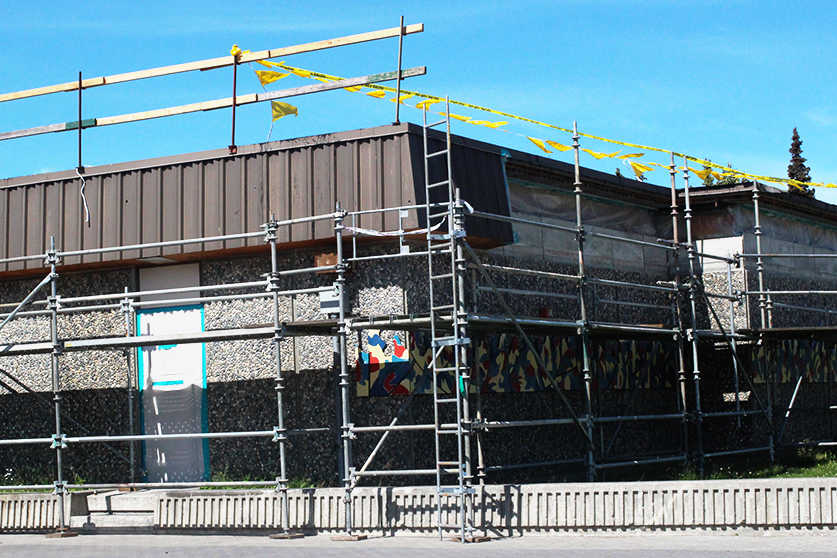When students and teachers abandoned Kenai Middle School for the summer, construction crews moved in. Asbestos fire retardant is being removed from the school roof’s structural beams and the roof itself is being replaced due to age, said Kenai Peninsula Borough School District Planning and Operations Director Julie Sisco.
When the school roof was built in 1972, its roof beams were coated with the silicate mineral asbestos — commonly used in buildings as a fire retardant prior to being banned in 1989 by the federal Environmental Protection Agency, which classifies it as a carcinogen. The material becomes dangerous when airborne fibers of it are caught in the lungs, according to a National Cancer Institute Website.
In addition to asbestos removal, the 85,476-square-foot roof is being replaced “from the beams up,” Sisco said. She wrote in an email that the work has a $5.2 million budget, approximately $2 million of which is dedicated to the asbestos removal.
Kenai Peninsula Borough Safety Coordinator Mark Schaafsma manages asbestos for the borough, though he isn’t directly overseeing the Kenai Middle School project. He said one project had required the other.
“The asbestos is just below the roof line, and the re-roofing project they’re going to do had a high potential for disturbing the asbestos materials inside the building,” he said. “So we want to remove the asbestos first before we did the re-roofing.”
Under normal conditions the fire-proofing in the roof doesn’t create an exposure hazard, Schaafsma said, because the asbestos isn’t in the form of fine air-born particles.
“Asbestos was used in literally thousands of man-made products all during most of the 20th century,” Schaafsma said. “In many older buildings, built before 1980 or so, there’s a high probability there’s some asbestos materials in it … so it’s not surprising that we have asbestos in our schools, but we’ve slowly been eliminating it a little bit at a time. The Kenai Peninsula Borough and the school district don’t have the budget to have it removed all at one time, and frankly there’s no reason to when a lot of it is not creating an exposure hazard to the occupants.”
He said floor tiles in the school also contain a small amount of asbestos which is “bound up in the matrix of the product” and has little chance of becoming an airborne hazard.
The project will last two years, with half the area of the roof being stripped of asbestos and replaced each year.
“This year they’re doing just the academic wing, and in summer 2017 they’re going to do the athletic wing,” Schaafsma said.
Roofing contractors Orion Construction subcontracted the asbestos removal to Alaska Abatement, an Anchorage-based company that has done other asbestos removal on the Kenai Peninsula, according to its president John Anderson. Crews from his company did similar work in the Kenai City Hall two months ago, as well as removals from Kenai High School, Kaleidoscope School, the Old Carrs Mall, the Soldotna Sports Complex, and one very large job several years ago.
“We abated the entire Agrium plant for friable asbestos,” Anderson said. “That was a 3 1/2-year project. Unfortunately the plant shut down, and they had displaced employees. I’m a union contractor, so we had the union come down and train some of their displaced employees and used them to abate the plant, help the local economy.”
Asbestos removal work is regulated by federal organizations such as the Environmental Protection Agency and the Occupation Safety and Health Administration, and in Alaska by the state Department of Conservation’s Division of Air Quality. Alaska statute requires asbestos removers to take a 40-hour certification course with an 8-hour recertification class every year.
“Minimizing airborne fibers is a key,” Schaafsma said of the protective methods workers use. To this end, the air is misted and the asbestos coating is wetted before it’s removed by workers in respirators and disposable coveralls. The area where the work is being done is sealed to prevent the material from escaping.
Schaafsma estimated about 40 rooms in the academic wing of the Kenai Middle School had been sealed in double layers of plastic sheeting and ventilated to the outside through particle-catching filters. Anderson said asbestos removal outside the school building for beams along its perimeter will also use containment and wet removal methods.
Anderson and Schaafsma said that after being removed, the material’s ultimate destination is the Central Peninsula Landfill in Soldotna, where it is buried daily at a site dedicated to asbestos.
Anderson expected the asbestos removal to be done around next Thursday, though his crew will return next year for work on the other wing of the school.

